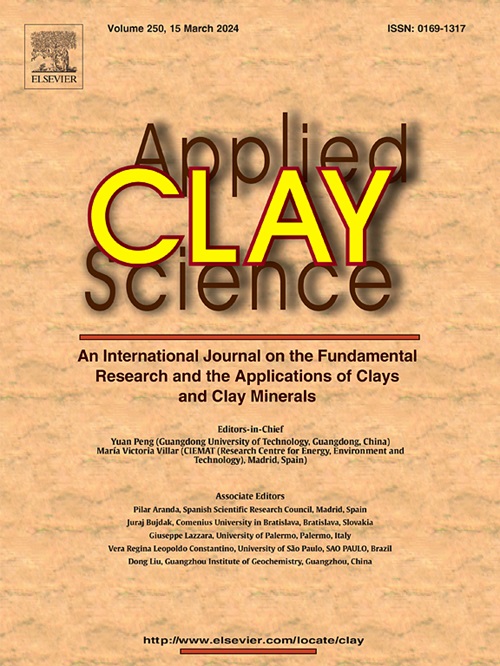含白云母和石英的低品位高岭土超快焦耳加热合成4A沸石与常规煅烧的比较
IF 5.8
2区 地球科学
Q2 CHEMISTRY, PHYSICAL
引用次数: 0
摘要
介绍了一种创新的以低品位高岭土为原料合成4a沸石的超快焦耳加热工艺,并与常规煅烧工艺进行了比较。采用x射线衍射(XRD)、傅里叶变换红外光谱(FT-IR)、矿物分离分析(MLA)、扫描电镜(SEM)、能谱分析(EDS)和热重分析(TGA)等方法对样品进行了综合表征。结果表明,原高岭土主要由高岭石、白云石和石英组成,石英和白云石作为杂质与高岭石密切共生。传统的煅烧不能转化白云母和石英,它们作为残留杂质残留在4a沸石产品中。在Al(OH)3和Na2CO3的作用下,通过超快焦耳加热快速生成前驱体(铝硅酸钠和正长石),并在1300℃下有效转化和利用白云母和石英杂质,然后通过水热处理将前驱体结晶合成4a沸石,将其Si和Al组分合并到沸石框架中。通过离子交换从白云母中释放的K+部分取代了分子筛骨架中的Na+,但分子筛4a的整体纯度和相均匀性明显提高。该研究为低品位高岭土的资源化利用和沸石的合成提供了一条新的高效途径。本文章由计算机程序翻译,如有差异,请以英文原文为准。

Synthesis of zeolite 4A from low-grade kaolin containing muscovite and quartz via ultrafast Joule heating route: A comparison with conventional calcination
This study introduced an innovative ultrafast Joule heating route for synthesizing zeolite 4 A from low-grade kaolin and made a comparison with the conventional calcination route. Comprehensive characterization was conducted using X-ray diffraction (XRD), Fourier transform infrared spectroscopy (FT-IR), mineral liberation analysis (MLA), scanning electron microscopy (SEM), energy-dispersive spectroscopy (EDS) and thermogravimetric analysis (TGA). The results indicate that the raw kaolin is primarily composed of kaolinite, muscovite, and quartz, with the latter two minerals intimately intergrown with kaolinite as impurities. Conventional calcination failed to convert muscovite and quartz, leaving them as residual impurities in the zeolite 4 A product. While precursors (sodium aluminosilicate and orthoclase) were rapidly generated by ultrafast Joule heating under the action of Al(OH)3 and Na2CO3, and the muscovite and quartz impurities were effectively converted and utilized at 1300 °C for 20s, the precursors were then crystallized through hydrothermal treatment to synthesize zeolite 4 A, incorporating their Si and Al components into the zeolite framework, and the partial replacement of Na+ in the zeolite framework by K+ released from muscovite via ion exchange, but the overall purity and phase uniformity of zeolite 4 A were significantly improved. This research provides a novel and efficient pathway for the resource utilization of low-grade kaolin and the synthesis of zeolites.
求助全文
通过发布文献求助,成功后即可免费获取论文全文。
去求助
来源期刊

Applied Clay Science
地学-矿物学
CiteScore
10.30
自引率
10.70%
发文量
289
审稿时长
39 days
期刊介绍:
Applied Clay Science aims to be an international journal attracting high quality scientific papers on clays and clay minerals, including research papers, reviews, and technical notes. The journal covers typical subjects of Fundamental and Applied Clay Science such as:
• Synthesis and purification
• Structural, crystallographic and mineralogical properties of clays and clay minerals
• Thermal properties of clays and clay minerals
• Physico-chemical properties including i) surface and interface properties; ii) thermodynamic properties; iii) mechanical properties
• Interaction with water, with polar and apolar molecules
• Colloidal properties and rheology
• Adsorption, Intercalation, Ionic exchange
• Genesis and deposits of clay minerals
• Geology and geochemistry of clays
• Modification of clays and clay minerals properties by thermal and physical treatments
• Modification by chemical treatments with organic and inorganic molecules(organoclays, pillared clays)
• Modification by biological microorganisms. etc...
 求助内容:
求助内容: 应助结果提醒方式:
应助结果提醒方式:


